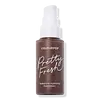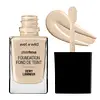Colourpop Pretty Fresh Hyaluronic Hydrating Foundation Versus Wet n Wild Photo Focus Dewy Liquid Foundation Makeup
What's inside
What's inside
 Key Ingredients
Key Ingredients

No key ingredients
 Benefits
Benefits

 Concerns
Concerns

 Ingredients Side-by-side
Ingredients Side-by-side

Water
Skin ConditioningCyclopentasiloxane
EmollientIsopentyldiol
HumectantGlycerin
HumectantDiisopropyl Dimer Dilinoleate
EmollientPolymethylsilsesquioxane
Hdi/Trimethylol Hexyllactone Crosspolymer
PEG-10 Dimethicone
Skin ConditioningPolyglyceryl-6 Polyricinoleate
EmulsifyingDisteardimonium Hectorite
StabilisingSodium Chloride
MaskingCitrullus Lanatus Fruit Extract
Skin ConditioningSodium Hyaluronate
HumectantLens Esculenta Fruit Extract
Skin ConditioningCocos Nucifera Water
MaskingMalus Sylvestris Flower Extract
AntioxidantSodium Lactate
BufferingSodium PCA
HumectantCocos Nucifera Fruit Juice
EmollientPhenoxyethanol
PreservativeCaprylyl Glycol
EmollientAluminum Dimyristate
Emulsion StabilisingTriethoxycaprylylsilane
Potassium Sorbate
PreservativeDisodium Stearoyl Glutamate
CleansingBHT
AntioxidantTrisodium EDTA
Hexylene Glycol
EmulsifyingIron Oxides
CI 77891
Cosmetic ColorantWater, Cyclopentasiloxane, Isopentyldiol, Glycerin, Diisopropyl Dimer Dilinoleate, Polymethylsilsesquioxane, Hdi/Trimethylol Hexyllactone Crosspolymer, PEG-10 Dimethicone, Polyglyceryl-6 Polyricinoleate, Disteardimonium Hectorite, Sodium Chloride, Citrullus Lanatus Fruit Extract, Sodium Hyaluronate, Lens Esculenta Fruit Extract, Cocos Nucifera Water, Malus Sylvestris Flower Extract, Sodium Lactate, Sodium PCA, Cocos Nucifera Fruit Juice, Phenoxyethanol, Caprylyl Glycol, Aluminum Dimyristate, Triethoxycaprylylsilane, Potassium Sorbate, Disodium Stearoyl Glutamate, BHT, Trisodium EDTA, Hexylene Glycol, Iron Oxides, CI 77891
Water
Skin ConditioningCyclopentasiloxane
EmollientC12-15 Alkyl Benzoate
AntimicrobialDiphenylsiloxy Phenyl Trimethicone
Skin ConditioningPEG-10 Dimethicone
Skin ConditioningIsopentyldiol
HumectantGlycerin
HumectantButylene Glycol Dicaprylate/Dicaprate
EmollientPentylene Glycol
Skin ConditioningSynthetic Fluorphlogopite
Lauryl PEG-10 Tris(Trimethylsiloxy)Silylethyl Dimethicone
EmulsifyingMagnesium Sulfate
Trimethylsiloxysilicate
EmollientPhenoxyethanol
PreservativeDisteardimonium Hectorite
StabilisingVinyl Dimethicone/Methicone Silsesquioxane Crosspolymer
Sorbitan Isostearate
EmulsifyingTriethoxycaprylylsilane
Ethylhexylglycerin
Skin ConditioningParfum
MaskingDisodium EDTA
Dimethicone
EmollientDimethicone/Vinyl Dimethicone Crosspolymer
Skin ConditioningHydrogenated Castor Oil Isostearate
Skin ConditioningCI 77891
Cosmetic ColorantIron Oxides
CI 77492
Cosmetic ColorantCI 77499
Cosmetic ColorantWater, Cyclopentasiloxane, C12-15 Alkyl Benzoate, Diphenylsiloxy Phenyl Trimethicone, PEG-10 Dimethicone, Isopentyldiol, Glycerin, Butylene Glycol Dicaprylate/Dicaprate, Pentylene Glycol, Synthetic Fluorphlogopite, Lauryl PEG-10 Tris(Trimethylsiloxy)Silylethyl Dimethicone, Magnesium Sulfate, Trimethylsiloxysilicate, Phenoxyethanol, Disteardimonium Hectorite, Vinyl Dimethicone/Methicone Silsesquioxane Crosspolymer, Sorbitan Isostearate, Triethoxycaprylylsilane, Ethylhexylglycerin, Parfum, Disodium EDTA, Dimethicone, Dimethicone/Vinyl Dimethicone Crosspolymer, Hydrogenated Castor Oil Isostearate, CI 77891, Iron Oxides, CI 77492, CI 77499
 Reviews
Reviews

Ingredients Explained
These ingredients are found in both products.
Ingredients higher up in an ingredient list are typically present in a larger amount.
Ci 77891 is a white pigment from Titanium dioxide. It is naturally found in minerals such as rutile and ilmenite.
It's main function is to add a white color to cosmetics. It can also be mixed with other colors to create different shades.
Ci 77891 is commonly found in sunscreens due to its ability to block UV rays.
Learn more about CI 77891Cyclopentasiloxane, or D5, is a silicone used to improve texture of products and trap moisture.
D5 is considered lightweight and volatile. Volatile means it evaporates quickly after application. Once evaporated, D5 leaves a thin barrier that helps keep skin hydrated.
It is also an emollient. Emollients help soften the skin and prevent water loss. Silicones create a silky texture in products. D5 helps other ingredients become more spreadable.
Studies show D5 is safe to use in skincare products. We recommend speaking with a skincare professional if you have concerns.
Learn more about CyclopentasiloxaneDisteardimonium Hectorite comes from the clay mineral named hectorite. It is used to add thickness to a product.
It can also help stabilize a product by helping to disperse other ingredients.
Hectorite is a rare, white clay mineral.
Learn more about Disteardimonium HectoriteGlycerin is already naturally found in your skin. It helps moisturize and protect your skin.
A study from 2016 found glycerin to be more effective as a humectant than AHAs and hyaluronic acid.
As a humectant, it helps the skin stay hydrated by pulling moisture to your skin. The low molecular weight of glycerin allows it to pull moisture into the deeper layers of your skin.
Hydrated skin improves your skin barrier; Your skin barrier helps protect against irritants and bacteria.
Glycerin has also been found to have antimicrobial and antiviral properties. Due to these properties, glycerin is often used in wound and burn treatments.
In cosmetics, glycerin is usually derived from plants such as soybean or palm. However, it can also be sourced from animals, such as tallow or animal fat.
This ingredient is organic, colorless, odorless, and non-toxic.
Glycerin is the name for this ingredient in American English. British English uses Glycerol/Glycerine.
Learn more about GlycerinIsopentyldiol is a synthetic solvent, humectant, and emollient.
Humectants have the ability to attract and hold water while emollients create a thin film to prevent water from evaporating. This combination keeps your skin and hair soft and hydrated. Plus, isopentyldiol does not leave a sticky feeling behind.
As a surfactant, isopentyldiol is a hydrotrope. Hydrotropes help surfactants (cleansing agents) dissolve into water.
According to the manufacturer, using this ingredient with sorbitol boosts skin hydration and helps close cuticles of damaged hair.
This ingredient is water-soluble.
Learn more about IsopentyldiolPeg-10 Dimethicone is silicone with conditioner and emulsifier properties. It mostly acts as an emollient in skincare and and humectant in haircare.
According to the manufacturer, acidic formulations decrease the stability of this ingredient. It works best in neutral or near neutral formulations.
Phenoxyethanol is a preservative that has germicide, antimicrobial, and aromatic properties. Studies show that phenoxyethanol can prevent microbial growth. By itself, it has a scent that is similar to that of a rose.
It's often used in formulations along with Caprylyl Glycol to preserve the shelf life of products.
Triethoxycaprylylsilane is a silicone used to bind and stabilize ingredients.
As an emulsifier, it helps prevent ingredients from separating. This can help elongate the shelf life of products.
Triethoxycaprylylsilane is often used to coat mineral sunscreens ingredients to help give a better feel. It also helps reduce oxidative stress in sunscreens.
Learn more about TriethoxycaprylylsilaneWater. It's the most common cosmetic ingredient of all. You'll usually see it at the top of ingredient lists, meaning that it makes up the largest part of the product.
So why is it so popular? Water most often acts as a solvent - this means that it helps dissolve other ingredients into the formulation.
You'll also recognize water as that liquid we all need to stay alive. If you see this, drink a glass of water. Stay hydrated!
Learn more about WaterThis ingredient is a combination of red, black, and yellow iron oxide pigments. This combination of colors is usually found in foundation, because it results in a "skin" color.